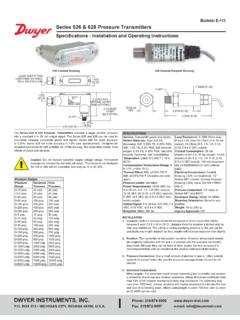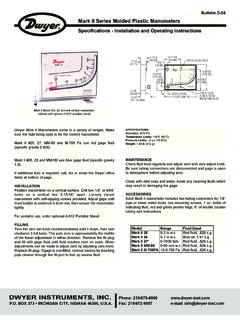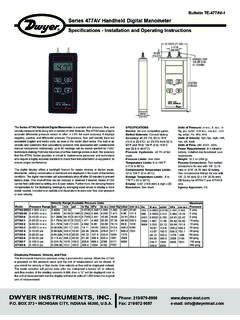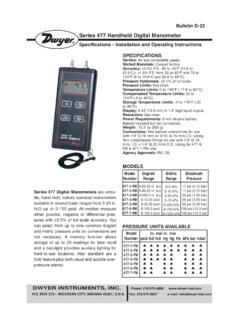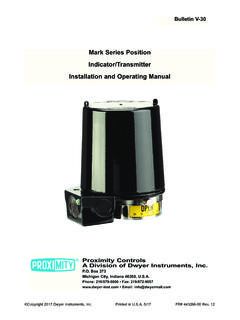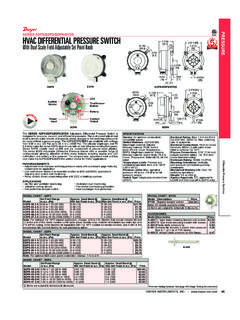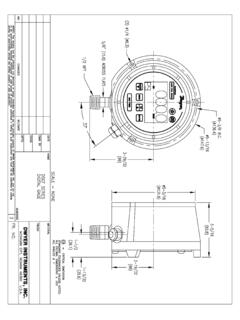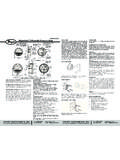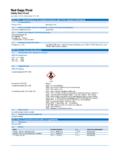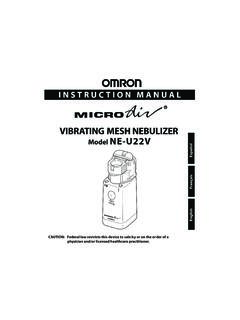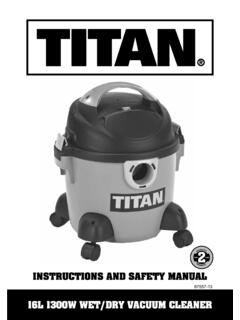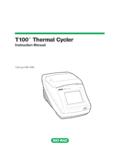Transcription of DWYER INSTRUMENTS, INC.
1 Bulletin P-3100 DWYER instruments , : 219/879-8000 BOX 373 MICHIGAN CITY, INDIANA 46360, Fax: 219/872-9057e-mail: - Installation and Operating InstructionsSeries 3100 Explosion-Proof Differential Pressure TransmitterTable of ContentsChapter 1. Using This Overview of Software CompatibilityChapter 2. Handling Unpacking Transmitters and Specifications Models and Specifications Selecting Installation Calibration after Pressure Waterproofing Cable Conduit Restrictions on Use of Radio Installation Resistance Test and Dielectric Strength Explosion-Proof EMC Conformity StandardsChapter 3. Transmitter Safety Fail Mode EEProm-Write Enable/Disable Mode Jumper Configuration of Alarm and Security Jumper Configuration of Zero and Span Commissioning on the Bench with HHTC hapter 4. Safety Commissioning on the Bench with Hand-Held General Electrical Considerations (Power Supply) Mechanical Environmental ConsiderationsChapter 5.
2 On-line Safety Configuration Data Configuration Basic Detailed Configuration Variables Diagnostics and CalibrationChapter 6. Safety Hardware Hardware MaintenanceAppendix I3100 Smart Pressure Transmitter LCD Display Code HART is a registered Trademark of Hart Communication FoundationPage 1 Chapter 1 IntroductionThe 3100 Smart Pressure Transmitter is calibrated at the factorybefore shipping. To ensure correct and efficient use of theinstrument, please read the manual thoroughly and fully understandhow to operate the instrument before The contents of this manual are subject to change without prior All rights are reserved. No part of this manual may be reproducedin any form without DWYER instruments , Inc. written If any question arises, errors are found or if any information is missing from this manual, please inform DWYER instruments , The specifications covered by this manual are limited to standard transmitters and do not cover custom-made Please note that changes in the specifications, construction, or component parts of the instrument may not immediately be reflected in this manual at the time of change, provided that postponement of revisions will not cause difficulty to the user from a functional or performance Using This ManualThe operating manual provides information on installing, operating,and maintaining the Mercoid Model 3100 Smart PressureTransmitter.
3 The Chapters are organized as 2 Handling CautionsChapter 2 provides instructions on commissioning and operating the Model 3100 Smart Pressure Transmitters. Informations on software functions, configuration parameters, and on-line variables are also included. Chapter 3 Transmitter FunctionsChapter 3 contains suggestions on handling the Model 3100 Smart Pressure Transmitter. Chapter 4 Installation Chapter 4 contains mechanical, environment consideration and electrical installation instructions for the Model 3100 Smart Pressure 5 On-line OperationChapter 5 describes how to configure the parameters of the Model 3100 Smart Pressure Transmitter. See the following list for the Regulations for circuit's Input/Output characteristics; Sensor or Output Trim2. Changing the output characteristic; Range Configuration, Output Type, Dampening, Unit3. Changing the general data; Tag No., Date, Message 6 MaintenanceChapter 6 contains hardware diagnostics, troubleshooting and maintenance Overview of TransmitterThe Mercoid Smart Pressure Transmitter is a microprocessorbased pressure transmitter with a capacitance sensor optimized fordraft measurement.
4 The Model 3100 has a true draft analog rangefrom 0 to 20 mA. This transmitter is explosion-proof, high precisionaccuracy, reliability and has digital communication for remotecommunication Model 3100 is enabled with HART communication with Host,HHT (HART Communicator) or PC Configurator. The transmitter svarious variables in host are able to be changed, configured andcalibrated by users. The HART Communication between DC powersupply and transmitter requires a 250~ 550 Ohm Software CompatibilityThe Mercoid Smart Pressure Transmitter's software is implementedat the factory. The following functions can be configured using aHHT (Hart Communicator). : Supported : Supported but update requiredFunctionZERO/SPANZERO TRIMZERO AdjUnits setRange setDampening setLCD decimal setFunction PC/PDA HARTHHT Page 3 HART is a registered Trademark of HART Communication Foundation Page 4 Chapter 2 Handling CautionsThis chapter consists of cautions for transmitter handling, storage,installation, insulation and explosion structure, andSpecifications StorageCalibrationInstallationLocationsM echanicalConsiderationsElectricalConside rationsMounting andInstallationCalibration on SpotPressure Operation Job Details- Unpack transmitter packing-Make sure the transmitter nameplate matches the model number on the In a dry, non-vibration and non-impact area - Ambient temperature around 77 F (25 C)
5 And 65% relative humidity- Configuration of the Range, Zero/Span, Unit, Tag, Dampening Time, Transfer Function, DA Trim and other parameters- Where ambient temperature are constant- Exposure to chemical corrosion, Where shock and vibration are minimal- Where the area classification does not exceed the explosion-proof rating- Where maintenance is easy- Where the transmitter can be handled easily- Be cautious of process connections leaking- 24 VDC(Power Supply is Vdc 45 Vdc)- For HART communication, resistance on transmitter terminal loop should be between 250 550 Ohms- When mounting the transmitter, an appropriate bracket should be used- The transmitter should be mounted securely to prevent swing- Sensor Zero Trim should be done ten seconds after differential pressure stabilizes- Make sure that PV value is zero and current is 4 mA- Do not apply a regulated differential pressure and line pressure- Close the equalizing valve on the 3 valve manifold and then open the valve on high and low side slowly and simultaneously- Make sure the transmitter operates properlyInstrument- HHT- Pressure Source- Galvanometer(Engineering)(Engineering)(E ngineering)(Mounting and Installation)HHT orZero/Span button(Applying pressure)Eye or HHTPage Unpacking TransmittersWhen moving the transmitter to the installation site, keep it in theoriginal packaging.
6 Unpack the transmitter at the installation site toavoid damage on the Model and Specifications CheckThe model number and specifications are indicated on thenameplate. Please check the specification and model StorageThe following precautions must be observed when storing theinstrument, especially for a long period of Select a storage area that meets the following conditions:- is not exposed to rain or minimal vibration and shock. - stored at normal temperature and humidity(approx. 77 F (25 C), 65% RH). The ambient temperature and relative humidity ratings are:Ambient Temperature: -40 to 185 F (-40 to 85 C)(without LCD module)-22 to 176 F (-30 to 80 C)(with LCD module)General Use:-4 to 140 F (-20 to 60 C)Relative Humidity: 5% ~ 98% RH at 104 F (40 C)2. When storing the transmitter, repack it the way it was delivered from the If storing a used transmitter, thoroughly clean the diaphragm surfaces, so that no media remains.
7 Make sure the transmitter assemblies are securely mounted before Selecting Installation Locations The transmitter is designed to withstand severe environmentalconditions. However, to ensure stable and accurate operation, thefollowing precautions must be observed when selecting aninstallation location. 1. Ambient TemperatureAvoid locations subject to wide temperature variations or a significant temperature gradient. If the location is exposed to radiant heat from plant equipment, provide adequate insulation or Ambient AtmosphereAvoid installing the transmitter in a corrosive atmosphere. If the transmitter must be installed in a corrosive atmosphere, there must be adequate ventilation. Precautions must be put into place to prevent intrusion or stagnation of rainwater in Shock and VibrationSelect an installation site with minimum shock and vibration (although the transmitter is designed to be relatively resistant to shock and vibration).
8 4. Installation of Explosion-Proof TransmittersExplosion-Proof transmitters can be installed in hazardous areas according to the gas types for which they are certified. 5. Select a place where the transmitter can be maintenanced Calibration after Installation1. Sensor Zero Trim should be done after transmitter is installed, because the zero point is not configured for mounting When calibrating the Sensor Zero Trim apply a pressure for zero in advance, Sensor Zero Trim the sensor when the pressure is sufficiently stabilized (after approximately 10 seconds).3. There are two ways to pressure zero. One way is to apply zero differential pressure (making pressure the same on both the high and low side). The other is to close High and Low side of a 3 valve manifold and open the equalizing Sensor Zero Trimming can also be done with the Zero/Span button or a HHT (HART Communicator), PC or PDA Refer to On-line Operation for configuring other parameters.
9 Pressure ConnectionsThe following precautions must be observed in order to safelyoperate the transmitter under Never apply a pressure higher than the specified maximum working Confirm the option pressure of transmitter. It is necessary to use standardized and quality-approved There should be isolation valves in case of leakage. Waterproofing Cable Conduit ConnectionsApply a non-hardening sealant (silicone or tape, etc.) to the threadsto waterproof the transmitter cable conduit Restrictions on Use of Radio Installation Resistance Test and Dielectric Strength TestSince the transmitter has undergone insulation resistance anddielectric strength tests at the factory, normally these tests are notrequired. However, if required, observe the following precautions inthe test procedures. 1. Do not perform such tests more frequently than necessary. Even test voltages, that do not cause visible damage to the insulation, may degrade the insulation and reduce safety Never apply a voltage exceeding 500 VDC for the insulation resistance test, or a voltage exceeding 500 VAC for the dielectric strength Before conducting these tests, disconnect all signal lines from the transmitter terminals.
10 Perform the tests in the following Resistance test1. Short-circuit the + and - SUPPLY terminals in the terminal Turn OFF the insulation tester. Then connect the insulation tester plus (+) lead-wire to the shorted SUPPLY terminals and the minus (-) lead wire to the grounding terminal. 3. Turn ON the insulation tester power and measure the insulation resistance. The voltage should be applied briefly to verify that insulation resistance is at least 20M .Although the transmitter has been designed to resist highfrequency electrical noise, if a radio transceiver is used near thetransmitters external wiring, the transmitter may be affected by high frequencynoise pickup. To test for such effects, bring the transceiver in slowly from a distanceof several feet from the transmitter, and observe the measurement loop for noiseaffects. Always use the transceiver outside the area affected by installed in the process under loosen or tighten as it may cause dangerous spouting ofprocess fluid.
